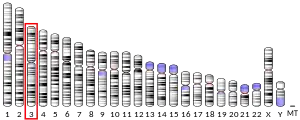Interleukin 20 receptor, beta subunit
Interleukin 20 receptor, beta subunit (IL20R2 or IL20RB) is a subunit of the interleukin-20 receptor and interleukin-22 receptor. It is believed to be involved in both pro-inflammatory and anti-inflammatory responses.[5][6]
IL20RB is found in many organ resident effector cells such as keratinocytes at the skin epidermis, osteoclasts, found in bones, and epithelial cells of the intestine and trachea. IL20RB is also found in some immune cells.[7] The subunit has been linked with multiple diseases, including gastrointestinal diseases and glaucoma.
Structure and function
IL20RB is a β-chain with a short intracellular domain. IL20RB, along with the IL-20 receptor, alpha subunit, form the heterodimeric type I interleukin-20 receptor, which binds the cytokines IL-20 and IL-24. IL20RB also associates with IL-22 receptor, to form the heterodimeric type II interleukin-20 receptor, which also binds IL-20 and IL-24.[6]
Signaling
After a cytokine binds both the IL20RB and the alpha subunit of the IL20 receptor, a signal is sent through the JAK-STAT signaling pathway. This signaling pathway leads STAT to act as a transcription factor, which can gene expression.[6]
Link to Immune System and Disease
IL20RB mRNA is present in some immune cells, including monocytes, natural killer cells, B-cells, T-cells, and some hematopoietic stem cells. It is known what role IL20RB plays in these cells.[6]
IL20RB is linked with atherosclerosis and gastrointestinal diseases, although its specific roles are unknown.[6]
Glaucoma
IL20RB mRNA is expressed in retinal ganglion cells and optic nerves in rats. Mutations in the IL20RB gene are associated with glaucoma. The specific links between IL20RB and glaucoma are unknown, but IL20RB does not have a causative effect on the disease, instead contributing to an increased risk of the disease along with other factors, such as intraocular pressure.[5][8]
References
- GRCh38: Ensembl release 89: ENSG00000174564 - Ensembl, May 2017
- GRCm38: Ensembl release 89: ENSMUSG00000044244 - Ensembl, May 2017
- "Human PubMed Reference:". National Center for Biotechnology Information, U.S. National Library of Medicine.
- "Mouse PubMed Reference:". National Center for Biotechnology Information, U.S. National Library of Medicine.
- Rutz S, Wang X, Ouyang W (December 2014). "The IL-20 subfamily of cytokines--from host defence to tissue homeostasis". Nature Reviews. Immunology. 14 (12): 783–795. doi:10.1038/nri3766. PMID 25421700.
- Wegenka UM (October 2010). "IL-20: biological functions mediated through two types of receptor complexes". Cytokine & Growth Factor Reviews. 21 (5): 353–363. doi:10.1016/j.cytogfr.2010.08.001. PMID 20864382.
- Kragstrup TW, Andersen T, Heftdal LD, Hvid M, Gerwien J, Sivakumar P, et al. (2018-09-25). "The IL-20 Cytokine Family in Rheumatoid Arthritis and Spondyloarthritis". Frontiers in Immunology. 9: 2226. doi:10.3389/fimmu.2018.02226. PMC 6167463. PMID 30319661.
- Wirtz MK, Keller KE (2016-01-20). "The Role of the IL-20 Subfamily in Glaucoma". Mediators of Inflammation. 2016: 4083735. doi:10.1155/2016/4083735. PMC 4745377. PMID 26903709.
Further reading
- Dumoutier L, Leemans C, Lejeune D, Kotenko SV, Renauld JC (October 2001). "Cutting edge: STAT activation by IL-19, IL-20 and mda-7 through IL-20 receptor complexes of two types". Journal of Immunology. 167 (7): 3545–3549. doi:10.4049/jimmunol.167.7.3545. PMID 11564763.
- Parrish-Novak J, Xu W, Brender T, Yao L, Jones C, West J, et al. (December 2002). "Interleukins 19, 20, and 24 signal through two distinct receptor complexes. Differences in receptor-ligand interactions mediate unique biological functions". The Journal of Biological Chemistry. 277 (49): 47517–47523. doi:10.1074/jbc.M205114200. PMID 12351624.
- Pletnev S, Magracheva E, Kozlov S, Tobin G, Kotenko SV, Wlodawer A, Zdanov A (November 2003). "Characterization of the recombinant extracellular domains of human interleukin-20 receptors and their complexes with interleukin-19 and interleukin-20". Biochemistry. 42 (43): 12617–12624. doi:10.1021/bi0354583. PMID 14580208.
- Zhang Z, Henzel WJ (October 2004). "Signal peptide prediction based on analysis of experimentally verified cleavage sites". Protein Science. 13 (10): 2819–2824. doi:10.1110/ps.04682504. PMC 2286551. PMID 15340161.



